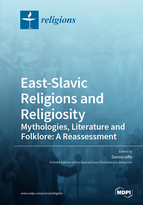East-Slavic Religions and Religiosity: Mythologies, Literature and Folklore: A Reassessment
A special issue of Religions (ISSN 2077-1444).
Deadline for manuscript submissions: closed (7 June 2021) | Viewed by 58682
Special Issue Editor
Interests: area studies; literary studies; media; philosophy; history of religions; art history; theatre and performing arts; translation studies; comparative cultural history; literature; language and text analysis
Research Period: 19th Century; 20th Century; Contemporary
Special Issues, Collections and Topics in MDPI journals
Special Issue Information
Dear Colleagues,
The focus of this Special Issue is Slavic religion and mythology, as reflected in theory, literature and folklore. Our volume will address various forms of pre-Christian religious beliefs, myths and ritual practices of the Slavs seeping through into "double beliefs" (as in alleged "dvoeverie" remnants). Along with that, we will also address the uneasy ways Christian Orthodoxy handled various challenges traditionally posed by popular beliefs and mythologies. Most existing studies focused on these questions are relatively dated, and there is a growing need for fresh scholarly approaches and reassessments.
The scope of our volume extends to various forms of Slavic religions, mythology, folklore and their intersections and interaction with literature and other creative arts. This will be examined in reference to historical as well as contemporary material. We will seek to contribute to the scholarship in these areas with regard to both officially sanctioned and heterodox religious practices. By doing so, we will bring together archaic forms of religious spirituality and modern literary worlds, embracing folklore analysis along with philosophical and theological ideas.
No collective volume to date has focused on such an ambitious interdisciplinary project. Most existing studies deal with the topic of Slavic mythology or religion from purely historical or folklorist standpoints. In this Special Issue, we add to this by including philosophy, creative arts, modern theory and critiques. This, we hope, will shed more light on ways in which mythologies and religious traditions inform ideas and artistic practices, past and present.
General topics of the volume:
- Religious traditionalism, fundamentalism, occult-mystical tradition and their ideological aspects in literature, culture, various relevant motifs in the oeuvre of Slavic authors;
- Slavic folklore and popular culture in general—philosophical and theoretical critique, religious and occult texts;
- Slavic literature (including theatre), its mythological and religious motifs;
- Slavic Free-Masonry of the 18th–19th centuries and its secret mythology;
- Modern Orthodox Fundamentalism, Slavic Neopaganism;
- All analyses of Slavic religious experience of folklore, Slavic popular religious culture, occult themes and topics of sectarian mythology and discourse.
The chronological framework of the project is not limited to any specific period.
Among the confirmed participants in the current volume are leading scholars from the top academic institutions in the US, Western Europe and Russian Federation.
Prof. Dr. Dennis Ioffe
Guest Editor
Manuscript Submission Information
Manuscripts should be submitted online at www.mdpi.com by registering and logging in to this website. Once you are registered, click here to go to the submission form. Manuscripts can be submitted until the deadline. All submissions that pass pre-check are peer-reviewed. Accepted papers will be published continuously in the journal (as soon as accepted) and will be listed together on the special issue website. Research articles, review articles as well as short communications are invited. For planned papers, a title and short abstract (about 100 words) can be sent to the Editorial Office for announcement on this website.
Submitted manuscripts should not have been published previously, nor be under consideration for publication elsewhere (except conference proceedings papers). All manuscripts are thoroughly refereed through a double-blind peer-review process. A guide for authors and other relevant information for submission of manuscripts is available on the Instructions for Authors page. Religions is an international peer-reviewed open access monthly journal published by MDPI.
Please visit the Instructions for Authors page before submitting a manuscript. The Article Processing Charge (APC) for publication in this open access journal is 1800 CHF (Swiss Francs). Submitted papers should be well formatted and use good English. Authors may use MDPI's English editing service prior to publication or during author revisions.
Keywords
- Slavic paganism
- Slavic mythology
- Slavic folklore
- Christian Orthodoxy
- phenomenology of religion
- Slavic studies
- Slavic popular religious culture
- occultism
- literature and mythology
- cultural history






